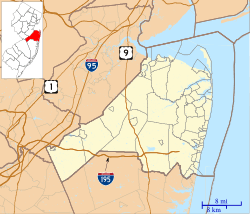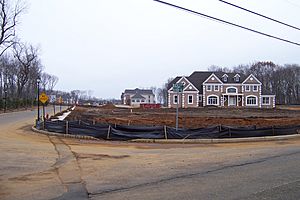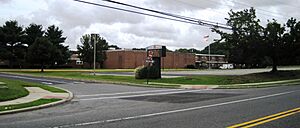Marlboro Township, New Jersey facts for kids
Quick facts for kids
Marlboro Township, New Jersey
|
||
|---|---|---|
|
Township
|
||
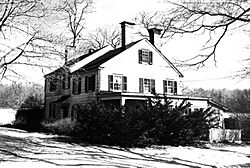
Asher Holmes House
|
||
|
||
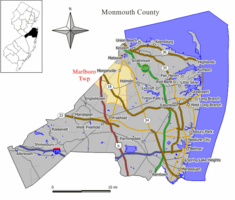
Location of Marlboro Township in Monmouth County highlighted in orange (right). Inset map: Location of Monmouth County in New Jersey highlighted in black (left).
|
||

Census Bureau map of Marlboro Township, New Jersey
<mapframe text="Interactive map of Marlboro Township, New Jersey" zoom="8" width="250" height="250"> { "type": "ExternalData", "service": "geoshape", "ids": "Q782591" } </mapframe> |
||
| Country | ||
| State | ||
| County | Monmouth | |
| Incorporated | February 17, 1848 | |
| Named for | Marl beds | |
| Government | ||
| • Type | Faulkner Act (mayor–council) | |
| • Body | Township Council | |
| Area | ||
| • Total | 30.45 sq mi (78.85 km2) | |
| • Land | 30.34 sq mi (78.58 km2) | |
| • Water | 0.11 sq mi (0.27 km2) 0.34% | |
| Area rank | 89th of 565 in state 9th of 53 in county |
|
| Elevation | 190 ft (60 m) | |
| Population
(2020)
|
||
| • Total | 41,502 | |
| • Estimate
(2023)
|
41,398 | |
| • Rank | 55th of 565 in state 3rd of 53 in county |
|
| • Density | 1,367.9/sq mi (528.1/km2) | |
| • Density rank | 348th of 565 in state 42nd of 53 in county |
|
| Time zone | UTC−05:00 (Eastern (EST)) | |
| • Summer (DST) | UTC−04:00 (Eastern (EDT)) | |
| ZIP Code |
07746 - Marlboro 07751 - Morganville 07726 - Englishtown
|
|
| Area code(s) | 732/848 | |
| FIPS code | 3402544070 | |
| GNIS feature ID | 0882118 | |
Marlboro Township is a town in Monmouth County, New Jersey. It's part of the New York metropolitan area. In 2020, about 41,502 people lived here. This was a small increase from 2010.
Marlboro Township became an official town on February 17, 1848. It was created from parts of Freehold Township. The town got its name from the marl beds found in the area. Marl is a type of soil that was used as fertilizer.
Contents
- A Look Back in Time
- Geography and Weather
- Population and Homes
- Fun and Recreation
- Education in Marlboro
- Transportation and Services
- Environmental Cleanup Efforts
- Sister Cities
- Famous People from Marlboro
- See also
A Look Back in Time
Early History of Marlboro
The First People Here
The Lenni Lenape Native Americans were the first known people to live here. They settled about a thousand years ago. They were farmers and lived in small villages. Some of their villages were in the Wickatunk and Crawford's Corner areas.
Many Lenape people died from European diseases. They had no natural protection against them. Their population also dropped because animals were over-hunted. Some Lenape had to trade their land for food and clothes. Eventually, many were moved to reservations.
European Settlers Arrive
The Dutch arrived in the region in the 1620s. Later, in 1664, the English took control. Four European explorers had claimed this land before. These were John Cabot, Giovanni de Verrazano, Estevan Gomez, and Henry Hudson.
The first European owners bought land from the Lenni Lenape leader, or Sakamaker. One of his sons, Weequehela, helped sell land to the first farmers.
In 1665, Richard Nicolls gave "The Monmouth Patent" to twelve men. They came from Long Island and New England. They were looking for religious freedom and new land.
By 1685, European farmers from Scotland, England, and the Netherlands settled here. The common language was Dutch. English and Scottish settlers were Quakers.
Quaker and Presbyterian Churches
The first settlers were Quakers, led by missionary George Keith. They started a town called "Topanemus." They built a meetinghouse and cemetery in 1702. The first church leader was Rev. George Keith. He received a large piece of land. This church later became St. Peter's Episcopal Church in Freehold. The old cemetery is still on Topanemus Road.
In 1692, Presbyterians built a church and cemetery. This was on what is now Gordons Corner Road. This church later moved and became the Old Tennent Church. It played a role in the American Revolutionary War. The old Scots Cemetery is still there.
Marl's Discovery and Use
The town of Marlboro is named after marl. This special soil was found here in 1768. Farmers used marl to make their soil better. It was like a natural fertilizer before modern ones existed.
Marlboro Township's first big business was selling marl. In 1853, marl was dug up and sent to other parts of New Jersey. It went by train to the Keyport docks. From there, it was shipped to New York and other places. Before marl was found, the area was called 'Bucktown'. This was after John Buck, who owned a tavern.
The Revolutionary War in Marlboro
Marlboro Township saw many small battles during the American Revolutionary War. This was especially true after the Battle of Monmouth in 1778. British soldiers often raided the Pleasant Valley area for food and animals. The locals fought back so fiercely that the area was called the "Hornet's Nest."
Beacon Hill was one of three places with beacons. These fires warned people and soldiers if the enemy was coming. British troops, after the Battle of Monmouth, tried to escape through the Montrose area.
The British also hunted animals in the woods. They hunted so much that deer almost disappeared from the northern part of the county.
How Marlboro Township Was Formed
Marlboro became an official township on February 17, 1848. It was formed from parts of Freehold Township. The name was first "Marlborough" but later changed to "Marlboro."
Marlboro used to be a very rural area. It had many dairy farms and grew lots of potatoes and tomatoes. Before World War II, Marlboro was the biggest potato grower in the country. It also had a big egg industry.
After World War II, roads and transportation improved. More people started moving to Marlboro. In the 1950s and 60s, the town grew a lot. New housing developments replaced farms. After the 1970s, Marlboro became a popular suburb for people working in New York. New homes became larger, and the town even put rules in place to protect wetlands from too much building.
Important Events in Marlboro's History
Town Center Changes
The old town center was around Main Street and School Road. It had hotels, a general store, and a Post Office. Today, Marlboro doesn't have one main town center. It's more spread out. There are plans to create a new "Village Center" that is easy to walk around.
Cell Phone Driving Ban
In 2000, Marlboro was the first town in New Jersey to ban cell phone use while driving. This rule started in March 2001. Police could stop drivers just for using their phones.
Marlboro Psychiatric Hospital
Marlboro Psychiatric Hospital opened in 1931. It was a large mental health hospital on 400 acres. It closed in 1998. The land was once farmland. There was also a cemetery for patients who died there. The hospital buildings were torn down in 2015. Most of the land is now part of the Monmouth County Park system. It is becoming Big Brook Park.
Green Energy Efforts
In 2009, Marlboro Township started using a large solar power system. It provides almost 40% of the town's electricity. This helps reduce pollution. Marlboro is known as a Cool City by the Sierra Club.
Preston Airfield
Marlboro used to have an airport called Preston Airfield. It opened in 1954 and operated for almost 50 years. It was used for private planes and flying lessons. Famous people like Jimmy Buffett and Jon Bon Jovi used it. The airport closed in 2000. Part of the land is now the Marlboro Memorial Cemetery.
Virgin Mary Sightings
Starting in 1989, Joseph Januszkiewicz reported seeing visions of the Virgin Mary in his yard. Many people came to pray and share in the visions. The Catholic Diocese of Trenton later said nothing "truly miraculous" was happening. The visions stopped in 2005.
Train Crash
On October 13, 1919, a train hit a truck at the Hudson Street crossing. The train derailed. Sadly, the train engineer, Michael Mooney, died from burns.
Historic Places to Visit
Marlboro Township has many historic sites. The Marlboro Township Historic Commission helps protect and share the town's history. They put up signs in front of important buildings. These signs explain their history. The Commission is made up of volunteers.
Geography and Weather
Marlboro Township covers about 30.47 square miles (78.92 square kilometers). Most of it is land. The soil is mostly made of sand, silt, and clay.
Some communities within Marlboro Township include Morganville and Robertsville. Other smaller areas are Beacon Hill, Bradevelt, and Wickatunk.
Marlboro Township borders several other towns. These include Aberdeen, Colts Neck, Freehold, Holmdel, Manalapan, and Matawan in Monmouth County. It also borders Old Bridge in Middlesex County.
Marlboro's Climate
Marlboro Township is close to the Atlantic Ocean.
- The warmest month is usually July. The average high is 85°F (29°C).
- The coolest month is January. The average low is 22°F (-6°C).
- The highest temperature ever was 106°F (41°C) in 1936.
- The lowest temperature ever was -20°F (-29°C) in 1934.
- July usually has the most rain. February has the least.
- Marlboro gets about 23.2 inches (59 cm) of snow each year.
Marlboro has a humid subtropical climate. This means it has warm, humid summers and mild winters. Some plants like palm trees and Southern Magnolias can even grow here.
Tornado in Marlboro
On October 16, 1925, a tornado hit Marlboro Township. It was less than a mile wide. It pulled up large trees, overturned small buildings, and knocked down telephone poles.
Population and Homes
| Historical population | |||
|---|---|---|---|
| Census | Pop. | %± | |
| 1850 | 1,564 | — | |
| 1860 | 2,083 | 33.2% | |
| 1870 | 2,231 | 7.1% | |
| 1880 | 2,193 | −1.7% | |
| 1890 | 1,913 | −12.8% | |
| 1900 | 1,747 | −8.7% | |
| 1910 | 1,754 | 0.4% | |
| 1920 | 1,710 | −2.5% | |
| 1930 | 1,992 | 16.5% | |
| 1940 | 5,015 | 151.8% | |
| 1950 | 6,359 | 26.8% | |
| 1960 | 8,038 | 26.4% | |
| 1970 | 12,273 | 52.7% | |
| 1980 | 17,560 | 43.1% | |
| 1990 | 27,974 | 59.3% | |
| 2000 | 36,398 | 30.1% | |
| 2010 | 40,191 | 10.4% | |
| 2020 | 41,502 | 3.3% | |
| 2023 (est.) | 41,398 | 3.0% | |
| Population sources: 1850–1920 1850–1870 1850 1870 1880–1890 1890–1910 1910–1930 1900–1990 2000 2010 2020 |
|||
Marlboro's population has grown steadily since 1940. The biggest growth happened in the 1960s and 1970s. From 1980 to 1990, over 10,000 more people moved in. The growth has slowed down recently.
In 2010, the average household income was $130,400. The average family income was $145,302.
Housing in Marlboro
The average home cost in Marlboro Township was about $446,890. Living here is more expensive than the U.S. average.
Marlboro Township has rules to provide homes for people with lower incomes. This is part of a state requirement.
Retirement Communities
Marlboro Township has several communities for older adults. These include:
- The Royal Pines at Marlboro
- The Sunrise Senior Community
- Greenbriar North Senior Housing Development (over 750 homes)
- Marlboro Greens (341 homes, built 1986-1988)
- Rosemont Estates (242 single-family homes)
- The Chelsea Square in Marlboro (225 condos for ages 55+)
Fun and Recreation
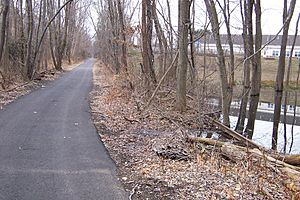
Marlboro has many recreation programs for all ages. There are active leagues for soccer and basketball. There's also Little League baseball/softball and Pop Warner football/cheerleading.
In the summer, the town hosts free outdoor concerts. Famous artists have performed here. Marlboro also has monthly indoor concerts. The Marlboro Players is a local theater group that puts on shows.
For walking and biking, parts of the Henry Hudson Trail go through the township.
Parks and Facilities
The Recreation Commission manages several parks. Some fields need permits to use. Here are some of the parks and what they offer:
| Park Name | Soccer | Hockey | Tennis | Handball | Tot-Lot | Basketball | Ball Field | Sitting Area | Open Field | Notes | Map |
|---|---|---|---|---|---|---|---|---|---|---|---|
| Marlboro Country Park |
|
|
|
|
|
|
Swim Club – Membership Required | Link | |||
| Hawkins Road Park |
|
|
|
|
|
Link | |||||
| Falson Park |
|
|
|
Walking Path Available | Link | ||||||
| Wicker Place Park |
|
|
|
Link | |||||||
| Marlin Estates Park |
|
|
|
|
Link | ||||||
| Nolan Road Park |
|
|
|
|
Tennis court is out of service and blocked off | Link | |||||
| Municipal Complex |
|
|
|
|
Shuffle Board, Walking Path, and shelter building | Link | |||||
| Defino Central School |
|
|
|
||||||||
| Robertsville School |
|
||||||||||
| Recreation Way Park |
|
|
|
Link | |||||||
| Union Hill Recreation Complex |
|
|
Walking Paths | Link | |||||||
| Vanderburg Sports Complex |
|
|
|
|
Aquatic Center – Membership Required | Link | |||||
| Brandigon Trail | Part of Henry Hudson Trail – about 20.27 Acres | Link | |||||||||
| Big Brook Park | A major site for fossils from the Cretaceous and Pleistocene ages See contaminated sites and hunting below |
Link |
Dog Parks
Marlboro has a special park for dogs to run off-leash. It's located at the town's municipal complex.
Fossil Hunting at Big Brook
Big Brook is a great place to find fossils. It's located on the border of Colts Neck and Marlboro. You can find shark teeth, crab claws, and even dinosaur bone pieces. It's one of the top dinosaur fossil sites in New Jersey. In 2009, a leg bone from a duckbilled dinosaur was found. The first dinosaur discovery in North America happened in this area in 1858. The marl soil in the township helped preserve these fossils. You can get to the fossil beds from the bridge on Monmouth Road.
Golfing in Marlboro
Bella Vista Country Club has an 18-hole golf course. It's a private club.
Local Festivals
Marlboro hosts many fun events throughout the year:
- Music Festival (Spring)
- Dinosaur Day (April)
- Memorial Day Parade (May)
- Marlboro Stomp The Monster 5K & Festival (May)
- Marlboro Blues & BBQ Festival (Fall)
- Marlboro Day (Summer/Fall)
- Halloween Party & Parade (October)
- Multicultural Day (November)
Summer Camps
Marlboro Township offers a summer camp for elementary school children. It's a six-week program with an optional extra week of water activities.
Wineries
Education in Marlboro
Elementary and Middle Schools
The Marlboro Township Public School District serves students from pre-kindergarten through eighth grade. There are eight schools in the district:
- David C. Abbott Early Learning Center (kindergarten and preschool special education)
- Defino Central Elementary School (grades K–5)
- Frank J. Dugan Elementary School (grades K–5)
- Asher Holmes Elementary School (grades 1–5)
- Marlboro Elementary School (grades K–5)
- Robertsville Elementary School (grades 1–5)
- Marlboro Memorial Middle School (grades 6–8)
- Marlboro Middle School (grades 6–8)
High School Education
Most students from Marlboro Township attend Marlboro High School. It's part of the Freehold Regional High School District. Some Marlboro students also go to Colts Neck High School. This district serves students from several nearby towns. Marlboro High School has a Business Learning Center.
The school board has nine members. Marlboro Township has one member with 1.4 votes.
Private Schools in the Area
- The High Point Schools are private schools for students aged 5–21. They help students with emotional, behavioral, and learning challenges.
- Christian Brothers Academy is a Catholic high school for boys in Lincroft.
- Solomon Schechter Day School of Greater Monmouth County is a Jewish Day School for Pre-K to 8th grade.
- Shalom Torah Academy in Morganville is another independent Jewish day school.
The Devitte Military Academy used to be here. It was a school for boys. One of its buildings is now a Hindu-American Temple.
School Summary
| School name | Grades | Public | Sports facilities available | Student population | Notes | Map |
|---|---|---|---|---|---|---|
| David C. Abbott Early Learning Center |
|
|
|
Pre-School & Special Ed. | Link | |
| Asher Holmes Elementary School |
|
|
|
Link | ||
| Frank Defino Central Elementary School |
|
|
|
Link | ||
| Frank J. Dugan Elementary School |
|
|
|
Link | ||
| Marlboro Elementary School |
|
|
|
|||
| Robertsville Elementary School |
|
|
|
Link | ||
| Marlboro Middle School |
|
|
|
Teacher : Student Ratio is 1:13 | Link | |
| Marlboro Memorial Middle School |
|
|
|
Link | ||
| Solomon Schechter |
|
|
|
Jewish Day School | Link | |
| High Point Schools |
|
|
|
School for Emotional & Behavioral Problems | Link | |
| Marlboro High School |
|
|
|
Link | ||
| Collier High School |
|
|
Private school for students with disabilities |
Public Library
The Marlboro Free Public Library is open six days a week. It has meeting rooms and a large children's section. You can rent movies for free. Marlboro also has two Little Free Library locations. These are small boxes where people can share books.
Transportation and Services
Getting Around Marlboro
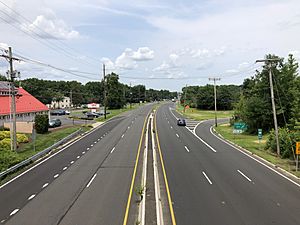
Cars are the most common way to travel in Marlboro. Major roads include U.S. Route 9, Route 18, and Route 79. These roads connect to larger highways like the Garden State Parkway.
Public Transportation Options
- Buses: NJ Transit buses go to New York City and Newark.
- Trains: The Aberdeen–Matawan station offers train service to New York City. Parking at the station can be difficult.
- Ferries: You can take a ferry from Highlands to New York City. This is about a 25-minute drive from Marlboro. Ferries also offer seasonal trips to places like Sandy Hook.
- Airports: The closest small airport is Old Bridge Airport. The nearest major airport is Newark Liberty International Airport. It's about a 39-minute drive away.
Healthcare Services
Marlboro Township is served by CentraState Healthcare System. This hospital is in nearby Freehold Township. It has a family doctor's office in Marlboro. Other nearby hospitals include Bayshore Community Hospital and Raritan Bay Medical Center.
Industrial Park
In 1958, Marlboro set aside 1,500 acres for businesses. This area is called the Marlboro Industrial Park. Its slogan is "You get a lot to like in Marlboro."
Environmental Cleanup Efforts
Marlboro Township has worked to clean up several sites. These areas had pollution from past activities.
Burnt Fly Bog Cleanup
Burnt Fly Bog is a large rural area. In the past, waste oil was stored in unlined ponds there. This caused pollution in the soil and water. Cleanup efforts have removed contaminated soil and sludge. A fence now surrounds the area to keep people safe. The site is regularly checked to make sure it stays clean.
Imperial Oil Co. Site
The Imperial Oil Co. site was added to a national cleanup list in 1983. It had pollution from old industrial operations. This included chemicals and metals. Cleanup work has removed contaminated soil and waste. The area is now fenced off. The mayor called it "one of the worst in the country" before cleanup. Millions of dollars were spent to clean up the property.
Marlboro Middle School Fields
The soccer fields at Marlboro Middle School were once a cattle farm. Tests showed some pollution in the soil. The mayor closed the fields quickly. The town received money to clean up the soil.
Entron Industries Site
The Entron Industries site had pollution from making rocket launcher parts. The town received grants to investigate the site. It cost a lot of money to clean up the land. The site has now been redeveloped into a housing community called "Camelot at Marlboro."
Other Cleanup Sites
- Arky property: This used to be a car junkyard. It had chemicals and metals in the soil and water. Contaminated soil and buried drums were removed.
- DiMeo property: This land was bought for parks and trails. It had pollution from old farming activities, like arsenic and pesticides. The soil was cleaned up.
- Big Brook Park: This park land, once part of the psychiatric hospital, had some pollution. Studies found natural arsenic and other issues from old septic systems. Cleanup plans are in place.
- Marlboro Psychiatric Hospital: The hospital site itself had pollution. The state was responsible for cleaning it up. The old buildings were torn down.
- Murray property: This site also had pollution. Contaminated soil was removed from the area.
Sister Cities
Marlboro has two sister cities. These are towns that partner with Marlboro to share culture and ideas.
Nanto became Marlboro's first sister city in 1991. Wujiang became a sister city in 2011. Students from Wujiang City visit Marlboro every other summer for exchange programs.
Famous People from Marlboro
- John Boyd (1679–1708), the first Presbyterian minister in America.
- Chris Carrino, a sports announcer.
- Robert J. Collier (1876–1918), editor of Collier's Weekly.
- Alex DeJohn (born 1991), a professional soccer player.
- Frank Dicopoulos (born 1957), an actor from Guiding Light.
- Max Ehrich (born 1991), an actor from High School Musical 3: Senior Year.
- Jeff Feuerzeig (born 1964), a film director.
- Josh Flitter (born 1994), an actor in movies like Nancy Drew.
- Elmer H. Geran (1875–1954), a politician.
- Hunter Gorskie (born 1991), a professional soccer player.
- Mark Haines (1946–2011), a TV host on CNBC.
- Garret Hobart (1844–1899), the 24th Vice President of the United States.
- Asher Holmes (1740–1808), a colonel in the American Revolutionary War.
- John D. Honce (1834–1915), a politician who helped fishermen.
- Mike Kamerman, guitar player for the band Smallpools.
- Ellen Karcher (born 1964), a New Jersey state senator.
- Dan Klecko (born 1981), an NFL football player.
- Jeff Kwatinetz (born 1965), a Hollywood talent manager.
- Otandeka Laki (born 1996), a soccer player for the Uganda women's national team.
- Craig Mazin (born 1971), a screenwriter.
- Idina Menzel (born 1971), an actress and singer.
- Adam Mesh (born 1975), a reality TV show contestant.
- Akash Modi (born 1995), an artistic gymnast.
- Jim Nantz (born 1959), a sportscaster.
- Declan O'Scanlon (born 1963), a member of the New Jersey General Assembly.
- Kal Penn (born 1977), an actor.
- Melissa Rauch (born 1980), an actress from The Big Bang Theory.
- Tony Reali (born 1978), a TV host.
- John Reid (1683–1723), a county judge and surveyor.
- Howie Roseman (born 1975), General Manager of the Philadelphia Eagles.
- Felicia Stoler, a TV host.
- David Stone (born 1966), a Broadway producer.
- Rev. John Tennent (1707–1732), a Presbyterian Minister.
- Paul Wesley (born 1982), an actor from The Vampire Diaries.
- Sharnee Zoll-Norman (born 1986), a professional basketball player.
See also
 In Spanish: Municipio de Marlboro (Nueva Jersey) para niños
In Spanish: Municipio de Marlboro (Nueva Jersey) para niños



